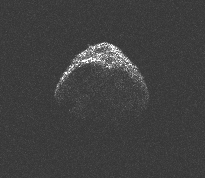Asteroid 2012 LZ1 is roughly spherical and rotates once around every 10-15 hours. This detailed image was taken when the asteroid was 10 million kilometers (6 million miles) away. The resolution is 7.5 m (25 feet), equivalent to seeing a basketball in New York City from Puerto Rico.
(Phys.org) -- Using the planetary radar system at Arecibo Observatory, astronomers have determined that asteroid 2012 LZ1 is twice as large as originally estimated based on its brightness, and large enough to have serious global consequences if it were to hit the Earth. However, a new orbit solution also derived from the radar measurements shows that this object does not have any chance of hitting the Earth for at least the next 750 years.
Asteroid 2012 LZ1 was discovered on June 10, 2012, at Siding Spring Observatory in Australia, and was classified as potentially hazardous by the Minor Planet Center because its preliminary orbit brings it close to Earth (within 20 lunar distances). Scientists at Arecibo observed the asteroid on June 19, 2012, to measure its orbit more precisely and to determine its size, rotation rate, and shape, and found it to be about 1 kilometer (0.6 miles) in its largest dimension. The new size determination suggests that 2012 LZ1 must be quite dark, reflecting only 2-4% of the light that hits it.
"The sensitivity of our radar has permitted us to measure this asteroid's properties and determine that it will not impact the Earth at least in the next 750 years," said Dr. Mike Nolan, Director of Planetary Radar Sciences at Arecibo Observatory. Dr. Ellen Howell added: "This object turned out to be quite a bit bigger than we expected, which shows how important radar observations can be, because we're still learning a lot about the population of asteroids."
More information: Scientists who worked on this investigation: Ellen S. Howell (Arecibo Observatory), Michael C. Nolan (Arecibo Observatory), Israel Cabrera (Arecibo Observatory), Jon Giorgini (Jet Propulsion Laboratory), and Marina Brozovic (Jet Propulsion Laboratory).
Provided by Arecibo Observatory























